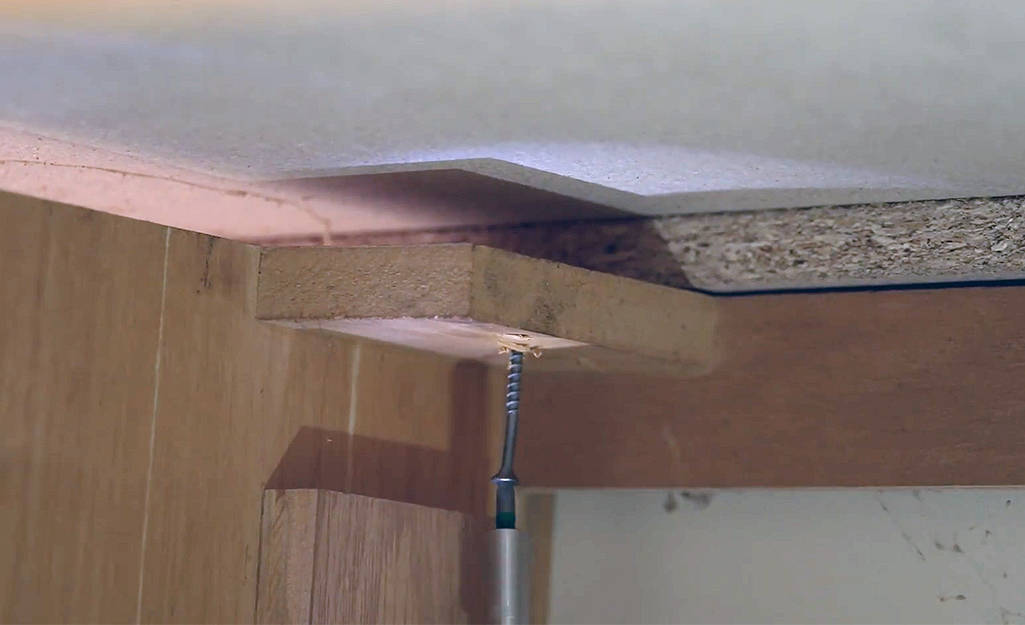So, you want to know how countertops are attached to cabinets and that tells me either you are doing this DIY or you feel your countertops are not safely secured to your cabinets.
These are two great reasons to be looking up this information and in this article, I am going to share with you exactly how your countertops should be installed on your cabinets.
All cabinets should be secured to your cabinets using glue, silicone, or screws depending on the type of countertops you are installing or having installed. The table below shows every countertop option and the adhesive required to safely secure your countertops to your cabinets.
[amazon box="B00EALQOFU,B07CHYCKQM,B001E3VQBE" grid="3"]
| Type Of Countertop | Adhesive Method |
|---|---|
| Granite | Silicone |
| Marble | Silicone |
| Quartz | Silicone |
| Quartzite | Silicone |
| Sintered Stone | Silicone |
| Laminate & Formica | Screws Underneath |
| Solid Surface | Silicone Or Screws Underneath |
| Wood | Screws Underneath |
| Tile | Screws Into Plywood |
It is important to know and understand how countertops are installed so that you can do this the right way and if you are having it done for you then you will know what to look for to ensure your countertops are installed properly and safely.
Installers sometimes get in a hurry and forget this step. Before they leave be sure to check and make sure it was done.
Also, if you aren't there for installation or didn't see this valuable information then it is probably ok and the weight of the countertops will likely hold just fine however it is important not to rely on this in itself. You may need to run a bead of silicone yourself and I will be adding a video soon to show you exactly how to do this.
Granite countertops are attached to your cabinets using silicone. Some installers will line a bead of silicone all over the top of your cabinets before setting the stone.
Granite countertop installers will also after the stone is installed they will run a bead of silicone along the edge where the granite countertop underside meets the cabinet.
Marble countertops are also attached to your cabinets using silicone using the same methods as granite countertops. A bead of silicone may be used before installing the marble and then again after installation.
Quartz countertops are installed just like granite and marble. A bead of silicone may be used before the installation on the very top of your cabinets but this is not required. They will likely place a bead of silicone where your countertops meet your cabinet the corner of that section all through your kitchen.
Quartzite countertops are also attached to your cabinets just like granite marble and quartz. You will need to run a bead of silicone along the side of your cabinet where it meets the underside of your countertop.
It is advised to add a bead of silicone before the countertops are even sitting on your cabinets but not necessary.
Sintered stone countertops are attached using silicone in the same way as the above-mentioned countertop materials using silicone along the edge where the stone meets your cabinets.
Laminate countertops are attached differently than most other countertop options. For laminate countertops, you will use a screw underneath your countertops which screw at an angle into your cabinet then into your laminate countertop.
It is important to use screws that are long enough to hold your cabinet but not so long that they will go through the top of your countertop. Typically a 1.25" to 1.5" long screw is used to secure your laminate countertops to your cabinets. Be sure to measure the thickness before you drive in the screws. You don't want to penetrate the top of your countertop.
Here is a great read on installing laminate countertops by Home Depot
Solid surface countertops can be installed in two ways. They can be installed with a layer of plywood under the solid surface material or without it. If they have plywood they will be attached using glue then the countertop attached using screws just like laminate or Formica countertops.
Using a 1.25" to 1.5" screw drill this screw into your cabinet at an angle and into the bottom of the countertop. Be sure to measure the material to ensure you won't penetrate the very top of your countertop.
Wood countertops are almost always attached to your cabinet using screws just like for laminate or Formica and solid surface countertops. The best part about wood countertops is that they are the easiest to secure to your cabinets.
Some installers also use wood glue to attach wood countertops to the cabinet but I advise against that as it is much harder to remove later if you want to sand them or replace them. I have removed wood countertops many times with glue used to attach them and it sometimes splits the countertop wood and the cabinet wood causing damage.
If you are planning a project that involves tile countertops then I suggest that you reconsider. These countertops are the most labor-intensive to remove later and the most time-consuming.
Tile countertops are attached to the cabinet using various layers. First, a layer of plywood is used. This plywood is always screwed into your cabinet from the top of the plywood then covered with mortar and then tiles. Sometimes the installer will screw underneath rather than the top but 9 times out of 10 they are screwed into the cabinet from the top and bottom which makes it very hard to remove later.
Tile cabinets are my least favorite and are the most expensive to remove. I charge $5 to $10 per sq ft just for removal. Save yourself the trouble and money and skip out on tile.

No matter what be sure to follow these instructions if you are installing yourself and use them to know if your installers are using best practices for installing your countertops and attaching them to your cabinet the right way.
Feel free to use the contact page to reach out with any questions. I get a number of emails daily and I am always happy to help my readers.
